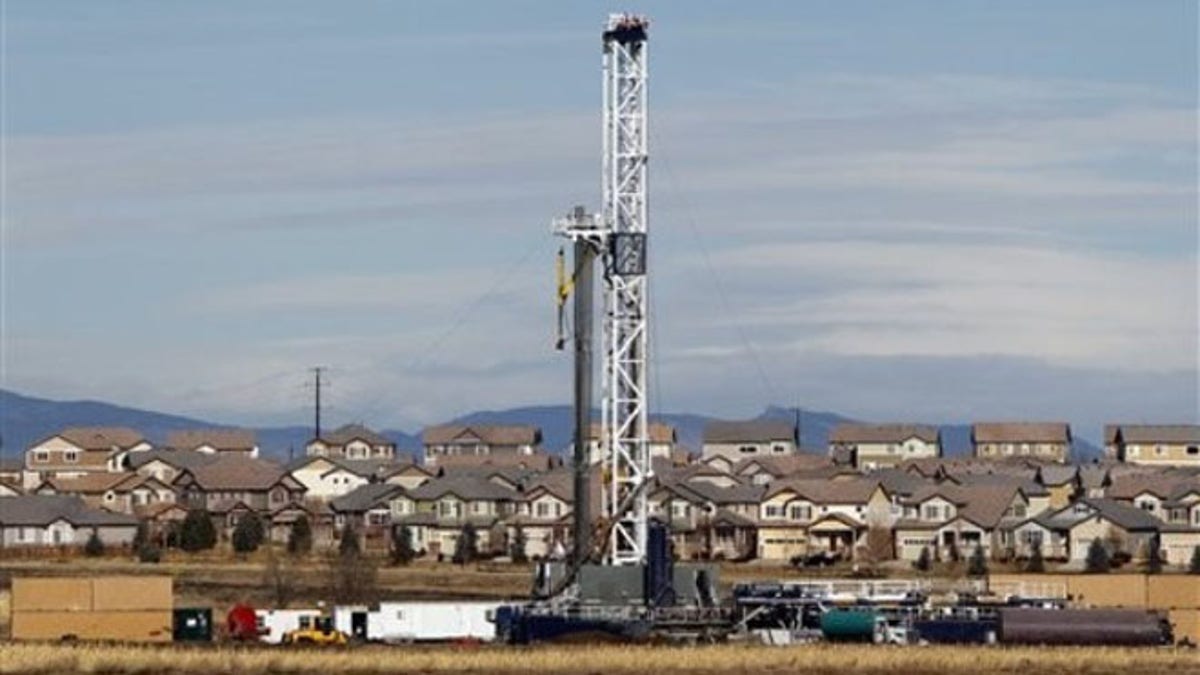
Jan. 18, 2012: Shown here is a rig drilling for oil near Frederick, Colo. (AP)
Republican senators are accusing President Obama of pushing a "less-than-honest" claim about the scarcity of domestic oil, after a U.S. Geological Survey study showed the United States might actually hold a quarter of the world's untapped, undiscovered supply.
The president often uses a much different statistic in speeches.
He said Tuesday, as he has before, that "the problem is we use more than 20 percent of the world's oil and we only have 2 percent of the world's proven oil reserves."
"Even if we drilled every square inch of this country right now, we'd still have to rely disproportionately on other countries for their oil," Obama said, while pitching a plan to crack down on oil market speculators.
But a U.S. Geological Survey released Wednesday paints a seemingly different picture. The analysis showed the world outside of the U.S. holds 565 billion barrels of undiscovered conventional oil -- it was the first such study in 12 years. The study did not address U.S. resources, but a prior analysis by the Energy Information Administration pegged the country's supply at 198 billion barrels. That works out to 26 percent of the world supply.
Sens. James Inhofe, R-Okla., and Lisa Murkowski, R-Alaska, suggested Thursday that the 2 percent stat is becoming obsolete.
"Well, there goes President Obama's favorite talking point," Inhofe said in a statement.
"The president's own administration has released a report which reveals that the United States has 26 percent of the world's technically recoverable conventional oil resources, and that's not including our enormous oil shale, tight oil and heavy oil resources. This report from the U.S. Geological Survey is vindication for anyone who thought that President Obama's claims ... are less than honest."
The president and the USGS, though, are referring to different kinds of oil reserves.
What the president talks about is "proven oil reserves" -- or oil deposits that have been discovered and are considered viable.
In the other, much bigger, category are the "undiscovered, technically recoverable" reserves -- or all the other stuff geologists estimate is out in the world regardless of how accessible or economically viable it might be. That's what the USGS looked at.
The Interior Department chided lawmakers for trying to suggest the new statistic contradicts the 2 percent figure used by Obama.
"This comparison confuses two very distinct concepts, each measuring a different set of facts," Interior Deputy Secretary David Hayes said in a statement, calling the two categories "apples and oranges."
He said the proven reserves -- the measurement used by Obama -- are the "well established" deposits.
"In other words, reserves are like cash in your bank account," he said.
All the rest, Hayes said, is "more like your long-term future earning potential."
"This study does not take into account any other factors such as whether or not a company might find it financially prudent to explore or develop," he said of the USGS analysis.
Outside of the United States, the USGS study found the bulk of the undiscovered reserves are in four regions. The region with the most is South America and the Caribbean, followed by sub-Saharan Africa; the Middle East and North Africa; and "Arctic provinces" of North America.
Interior Secretary Ken Salazar said in a statement that the new figures on global potential should help officials "make better decisions regarding both domestic and global energy policy and resource management." He stressed the importance of working with Western Hemisphere nations like Brazil, given how much oil the region potentially holds.
According to the Interior Department, foreign oil dependence has dropped every year under the Obama administration.




